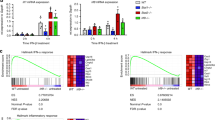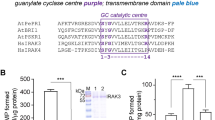Abstract
The transcription factor NF-κB coordinates the activation of numerous genes in response to pathogens and pro-inflammatory cytokines, and is, therefore, vital in the development of acute and chronic inflammatory diseases1,2,3,4,5,6. NF-κB is activated by phsophorylation of its inhibitory subunit, IκB-α (ref. 7), on serine residues 32 and 36 by cytokine-activated IκB kinases (IKKs); this phosphorylation precedes rapid degradation of IκB8,9,10,11. IKK-α and IKK-β isozymes are found in large complexes of relative molecular mass 700,000–900,000 (Mr 70K–90K), but little is known about other components that organize and regulate these complexes12,13,14,15,16,17. IKK-α was independently discovered as a NF-κB-inducing kinase18 (NIK)-associated protein in a yeast two-hybrid screen19, and IKK-β was also identified by homology screening20. It is, however, unknown whether NIK is part of the IKK complex. Here we isolate large, interleukin-1-inducible IKK complexes that contain NIK, IKK-α, IKK-β, IκB-α, NF-κB/RelA and a protein of Mr 150K. This latter component is a new protein, termed IKK-complex-associated protein (IKAP), which can bind NIK and IKKs and assemble them into an active kinase complex. We show that IKAP is a scaffold protein and a regulator for threedifferent kinases involved in pro-inflammatory cytokine signalling.
This is a preview of subscription content, access via your institution
Access options
Subscribe to this journal
Receive 51 print issues and online access
$199.00 per year
only $3.90 per issue
Buy this article
- Purchase on Springer Link
- Instant access to full article PDF
Prices may be subject to local taxes which are calculated during checkout





Similar content being viewed by others
References
Siebenlist, U., Brown, K. & Franzoso, G. in Inducible Gene Expression 1, (ed. Baeuerle, P. A.) 93–141 (Birkhaeuser, Boston,(1995).
Verma, I. M., Stevenson, J. K., Schwarz, E. M., Van Antwerp, D. & Miyamoto, S. Rel/NF-κB/IκB family: intimate tales of association and dissociation. Genes Dev. 9, 2723–2735 (1995).
Baeuerle, P. A. & Baltimore, D. NF-κB: ten years after. Cell 87, 13–20 (1996).
Baldwin, A. S. The NF-κB and I-κB proteins: new discoveries and insights. Annu. Rev. Immunol. 14, 649–681 (1996).
Thanos, A. M. & Maniatis, T. NF-κB: a lesson in family values. Cell 80, 529–532 (1995).
Baeuerle, P. A. & Baichwal, V. R. NF-κB as frequent target for immunosuppressive and anti-inflammatory molecules. Adv. Immunol. 6, 111–137 (1997).
Baeuerle, P. A. & Baltimore, D. IκB: a specific inhibitor of the NF-κB transcription factor. Science 242, 540–546 (1988).
Brockman, J. A.et al. Coupling of a signal response domain in IκB to multiple pathways for NF-κB activation. Mol. Cell. Biol. 15, 2809–2818 (1995).
Brown, K., Gerstberger, S., Carlson, L., Franzoso, G. & Siebenlist, U. Control of IκBα proteolysis by site-specific, signal-induced phosphorylation. Science 267, 1485–1491 (1995).
Traencker, E. B.-M.et al. Phosphorylation of human IκB-α on series 32 and 36 controls IκB-α proteolysis and NF-κB activation in response to diverse stimuli. EMBO J. 14, 2876–2883 (1995).
DiDonato, J. A.et al. Mapping of the inducible IκB phosphorylation sites that signal its ubiquitination and degradation. Mol. Cell. Biol. 16, 1295–1304 (1996).
Maniatis, T. Catalysis by a multiprotein IκB kinase complex. Science 278, 818–819 (1997).
Stancovski, I. & D. Baltimore. NF-κB activation: the IκB kinase revealed? Cell 91, 299–302 (1997).
Baeuerle, P. A. Pro-inflammatory signaling: last pieces in the NF-κB puzzle? Curr. Biol. 8, 19–22 (1998).
DiDonato, J. A., Hayakawa, M., Rothwarf, D. M., Zandi, E. & Karin, M. Acytokine-responsive IκB kinase that activates the transcription factor NF-κB. Nature 388, 548–554 (1997).
Zandi, E., Rothwarf, D. M., Delhase, M., Hayakawa, M. & Karin, M. The IκB kinase complex (IKK) contains two kinase subunits, IKKα and IKKβ, necessary for IκB phosphorylation and NF-κB activation. Cell 91, 243–252 (1997).
Mercurio, F.et al. IKK-1 and IKK-2: cytokine-activated IκB kinases essential for NF-κB activation. Science 278, 860–866 (1997).
Malinin, N. L., Boldin, M. P., Kovalenko, A. V. & Wallach, D. MAP3K-related kinase involved in NF-κB induction by TNF, CD95 and IL-1. Nature 385, 540–544 (1997).
Régnier, C. H.et al. Identification and characterization of an IκB kinase. Cell 90, 373–383 (1997).
Woronicz, J. D., Gao, X., Cao, Z., Rothe, M. & Goeddel, D. V. IκB kinase-β: NF-κB activation and complex formation with IκB kinase-α and NIK. Science 278, 866–869 (1997).
Yajima, H., Tokunaga, M., Nakayama-Murayama, A. & Hishinuma, F. Characterization of IKI1 and IKI3 genes conferring pGKL killer sensitivity on Saccharomyces cerevisiae. Biosci. Biotech. Biochem. 61, 704–709 (1997).
Neer, E. J., Schmidt, C. J., Nambudripad, R. & Smith, T. F. The ancient regulatory-protein family of WD-repeat proteins. Nature 371, 297–300 (1994).
Cao, Z., Xiong, J., Takeuchi, M., Kurama, T. & Goeddel, D. V. TRAF-6 is a signal transducer for interleukin-1. Nature 383, 443–446 (1996).
Lei, L., Cao, Z. & Goeddel, D. V. NF-κB-inducing kinase activates IKK-α phosphorylation of Ser-176. Proc. Natl Acad. Sci. USA 95, 3792–3797 (1998).
Nakano, H.et al. Differential regulation of the IκB kinase α and β by two upstream kinases, NF-κB-inducing kinase and mitogen-activated protein kinase/ERK kinase kinase-1. Proc. Natl Acad. Sci. USA 95, 3527–3542 (1998).
Choi, K. Y., Scatterberg, B., Lyons, D. M. & Ellion, E. A. Ste5 tethers multiple protein kinases in the MAP kinases in the MAP kinase cascade required for mating of S. cerevisiae. Cell 78, 499–512 (1994).
Printen, J. A. & Sprague, G. F. J Protein–protein interactions in the yeast pheromone response pathway: Ste5p interacts with all members of the MAP kinase cascade. Genetics 138, 609–619 (1994).
Marcus, S., Polverino, A., Barr, M. & Wigler, M. Complexes between Ste5 and components of the pheromone-responsive mitogen-activated protein kinase module. Proc. Natl Acad. Sci. USA 91, 7762–7766 (1994).
Cao, Z., Henzel, W. J. & Gao, X. IRAK: a kinase associated with the interleukin-1 receptor. Science 271, 1128–1131 (1996).
Henzel, W. J. & Stults, J. T. Reversed phase isolation of peptides. Curr. Prot. Protein Sci. 1 11.6.1–11.6.14 (1995).
Acknowledgements
We thank J. Woronicz, C. Régnier, M. Ayres, S. Li, C. Lehel and T. Hoey for providing reagents; K. Williamson for DNA sequencing; and C. Béraud, M. Rothe, Z. Cao and D. Goeddel for discussions throughout the project and comments on the manuscript.
Author information
Authors and Affiliations
Corresponding author
Rights and permissions
About this article
Cite this article
Cohen, L., Henzel, W. & Baeuerle, P. IKAP is a scaffold protein of the IκB kinase complex. Nature 395, 292–296 (1998). https://doi.org/10.1038/26254
Received:
Accepted:
Issue Date:
DOI: https://doi.org/10.1038/26254
This article is cited by
-
The Use of Bruton Tyrosine Kinase Inhibitors in Waldenström’s Macroglobulinemia
Clinical Hematology International (2022)
-
Toll-like receptor-mediated innate immunity against herpesviridae infection: a current perspective on viral infection signaling pathways
Virology Journal (2020)
-
TAT cell-penetrating peptide modulates inflammatory response and apoptosis in human lung epithelial cells
Drug Delivery and Translational Research (2015)
-
Noncanonical Nuclear Factor Kappa B (NF-κB) Signaling and Potential for Therapeutics in Sepsis
Current Infectious Disease Reports (2013)
-
Pathway analysis in blood cells of pigs infected with classical swine fever virus: comparison of pigs that develop a chronic form of infection or recover
Archives of Virology (2013)
Comments
By submitting a comment you agree to abide by our Terms and Community Guidelines. If you find something abusive or that does not comply with our terms or guidelines please flag it as inappropriate.



